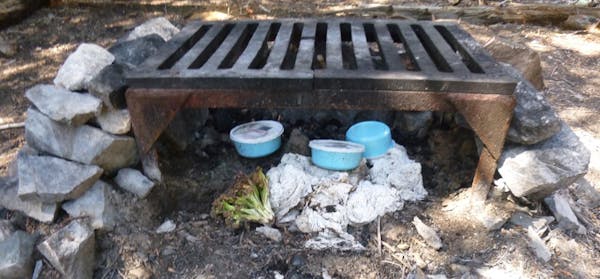Scarce as the world is of some things, a coronavirus vaccine being primary, overabundant are the tortured and oftentimes just plain whiny reflections of the fibbers, bellyachers and dingbats otherwise known as memoirists.
Relegated to the literary sidelines, meanwhile, are those who are genuinely worthy of consigning their life's story to pen and paper, not least Bob Nasby, the Twin Cities fisherman and fly-casting instructor.
Growing up tough in St. Paul, Bob drifted far afield as a youth, first by dabbling in spin fishing, then by getting hooked on the hard stuff, bobbers. In time he was caught red-handed with a flat of night crawlers and hit bottom when he was photographed, grinning, with a stringer of walleyes in each hand, a minnow bucket at his feet.
In recovery now, he casts only flies, and sometimes hookless ones at that.
"I feel bad about killing the walleyes," he said. "But as kids we needed the fish to eat. Now I can't stand eating fish."
This was the other day, and Bob and I were passing the good time in a Twin Cities park, reveling in Bob's latest fishing-related obsession: the collection, restoration and casting of centuries-old salmon rods, or what also are called spey rods.
Spey casting was developed in the British Isles because many salmon rivers there are wide and fast, with tree-lined banks, leaving no room for backcasts.
"It's my pandemic hobby," Bob said. "I have a computer now, and I find the rods on the internet in Scotland. When I do, I send money. Then a few weeks go by and the postman brings the rods to my door. Just like that. Reels, too. Big, brass fly reels. Some are 5 inches across. You could put bread and potato salad on them and have lunch."
I called fiddlesticks on the computer ownership claim.
"I do have a computer," Bob said. "First ever. But it's a one-way street. No one can contact me. Don't try contacting me."
As Bob spoke, he assembled a glistening 16-foot-long spey rod made of greenheart wood, which British rod-makers imported from South America beginning in the mid-1800s.
With durability similar to teak's, and so dense it has been known to explode when sawn, greenheart was a favorite of shipbuilders as well as rod-makers, in the latter case because it tends to bend, not break.
"Working on these rods is part of my pandemic routine," Bob said. "I don't go anywhere outside the house, except to cast, and at all times I'm 100 percent surrounded by hand sanitizer. From 7 to 8 in the morning I watch 'Andy Griffith' reruns. Then I pour a cup of coffee, go downstairs, listen to Mozart and refinish the rods I get in the mail from Scotland."
The rod Bob put together in the park was designed and probably built by Alexander Grant. Born in 1856 in the Scottish Highlands, Grant began his fishing career on the banks of the River Spey, a legendary waterway to which serious salmon fishers routinely genuflect.
A fly-fishing innovator, Grant in 1895 patented his "Vibrator" spey rod.
Made of multiple sections, the rod incorporated a unique lap joint system in which each rod section is planed to a point, allowing it to fit imperceptibly to the next section. The joints were held together by linseed-treated leather lace.
Grant's goal was to construct rods that flexed uniformly throughout their length, allowing them to cast lines farther than other lines of his time. This was important because salmon had long since learned to avoid flies cast 40 yards from shore — the distance reached by most casters — by swimming 50 yards from shore.
"Then along came Grant," Bob said. "In one casting contest, using a 21-foot Vibrator rod, he stripped 65 yards of line off his reel, lifted all of the line off the water, backcast once and cast it straight ahead without 'shooting' any of it. He beat the second-place caster by 9 yards. He also caught the salmon that were avoiding the other casters."
A competitive fly caster himself, Bob soon peeled line from the lunch-plate-size reel attached to his 19th-century greenheart rod, then peeled more line from the reel and more still.
Just as effortlessly he roll cast about 70 feet of line onto the water,
"Let me try that," I said.
Unable to match Bob's aerobatics, in a few tries I nevertheless completed a handful of journeyman-like efforts. As most spey casts are, these were two-handed throws, differing in that respect from modern single-handed fly casting.
"Where are you going to fish with these rods?"
"The St. Croix for carp for sure," Bob said. "And this fall, I'll fish steelhead with them in the Wisconsin Brule. The Brule isn't as wide as Scotland's rivers. But it's wide enough. And being able to cast from places where, because of trees on the stream banks, no other cast is possible except a long roll cast, I'll be able to reach some good lies in the river."
With that, Bob loaded his vintage rods into his pickup and drove away, noting as he did his truck has never been driven faster than 65 miles per hour.
"Not once in 11 years," he said.
Get that in the memoir.
dennis.anderson@startribune.com

Anderson: Building a new Waterville fish hatchery will help shorten the time between bites

Anderson: Trailblazing sonar will be in thousands of boats for opener

Anderson: Celebrate Earth Day by rekindling real connection to nature
Anderson: Anglers protesting tough new Mille Lacs rules are wrong


